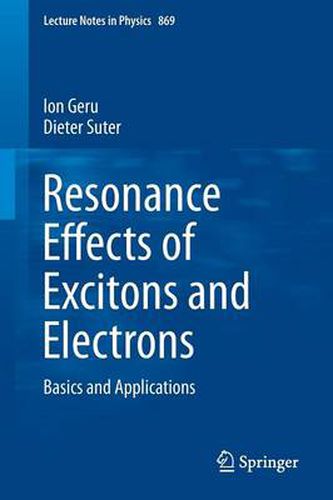Readings Newsletter
Become a Readings Member to make your shopping experience even easier.
Sign in or sign up for free!
You’re not far away from qualifying for FREE standard shipping within Australia
You’ve qualified for FREE standard shipping within Australia
The cart is loading…






This title is printed to order. This book may have been self-published. If so, we cannot guarantee the quality of the content. In the main most books will have gone through the editing process however some may not. We therefore suggest that you be aware of this before ordering this book. If in doubt check either the author or publisher’s details as we are unable to accept any returns unless they are faulty. Please contact us if you have any questions.
This book presents the various types of resonance effects on excitons, biexcitons and the local electronic centers (LEC) in solids, such as paramagnetic and paraelectric resonances on excitons, exciton acoustic resonance at intra- and interband transitions, radio-optical double resonance on excitons, hole-nuclear double resonance on localized biexcitons, ENDOR and acoustic ENDOR on LEC. The criteria for the generation of coherent photons, phonons and magnons by excitons are explained. The interactions of excitons and biexcitons with paramagnetic centers and nuclear spins, the indirect interaction between the PC through a field of excitons as well as the quasienergy spectrum of excitons and spin systems are discussed. It is proved that the interaction of paramagnetic centers with excitons increases the spin relaxation rate of paramagnetic centers in comparison with the case of their interaction with free carriers. The giant magneto-optical effects in semi-magnetic semiconductors are theoretically interpreted.
In recent years, a new perspective has been added to these systems and their interactions: They can be used for storing and processing information in the form of quantum bits (qubits), the building blocks of quantum computers. The basics of this emerging technology are explained and examples of demonstration-type quantum computers based on localized spins in solids are discussed.
$9.00 standard shipping within Australia
FREE standard shipping within Australia for orders over $100.00
Express & International shipping calculated at checkout
This title is printed to order. This book may have been self-published. If so, we cannot guarantee the quality of the content. In the main most books will have gone through the editing process however some may not. We therefore suggest that you be aware of this before ordering this book. If in doubt check either the author or publisher’s details as we are unable to accept any returns unless they are faulty. Please contact us if you have any questions.
This book presents the various types of resonance effects on excitons, biexcitons and the local electronic centers (LEC) in solids, such as paramagnetic and paraelectric resonances on excitons, exciton acoustic resonance at intra- and interband transitions, radio-optical double resonance on excitons, hole-nuclear double resonance on localized biexcitons, ENDOR and acoustic ENDOR on LEC. The criteria for the generation of coherent photons, phonons and magnons by excitons are explained. The interactions of excitons and biexcitons with paramagnetic centers and nuclear spins, the indirect interaction between the PC through a field of excitons as well as the quasienergy spectrum of excitons and spin systems are discussed. It is proved that the interaction of paramagnetic centers with excitons increases the spin relaxation rate of paramagnetic centers in comparison with the case of their interaction with free carriers. The giant magneto-optical effects in semi-magnetic semiconductors are theoretically interpreted.
In recent years, a new perspective has been added to these systems and their interactions: They can be used for storing and processing information in the form of quantum bits (qubits), the building blocks of quantum computers. The basics of this emerging technology are explained and examples of demonstration-type quantum computers based on localized spins in solids are discussed.